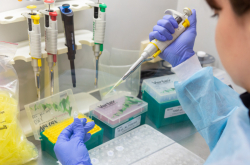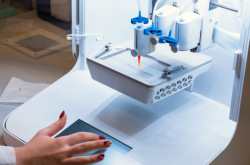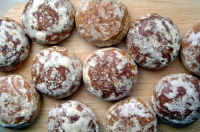The course includes ten classes split into two parts: during the first, theoretical part, Ilya cooks while the students taste the end product and discuss the cooking process; the second part is practice-oriented. During their studies, the students go all the way from learning about the basic ingredients to getting a grasp of the modern serving techniques used in restaurants. What makes the course unique is that the participants will cook dishes they’re familiar with, but in unexpectedly delicious ways. The main idea is to turn regular food into something refined and tasty. For instance, Ilya will teach the students to cook eggs ten different ways. Some less obvious tricks include transforming the visual and flavor aspects of ingredients. At one of the classes, Mr. Litvyak has already demonstrated how one can change the taste and shape of carrots and celery roots – next up, he will show how to cook a pear in a way that would change its color and make it taste like caramel. He also dedicates some time to debunk various culinary myths.

Ilya Litvyak
“The point of this course is that “scientific” approach to cooking does not require any special equipment – to achieve impressive results, all you need is an understanding of the nature of the underlying processes. You can cook with knowledge or with intuition. I don’t claim that knowledge makes your food tastier, but it will at least help you cook exactly what you wanted to. If you know how it works, you can plan out a specific kind of omelet, for example, and end up with just that. When you don’t know the inner workings of cooking and what depends on what, the result may sometimes disappoint you – but the saddest part is that you’ll never learn what went wrong. After all, there are many kinds of omelets: to make some, you need to know about evaporation; others – about fats, etc. This is why the scientific approach to food exists. My course’s general idea is that it’s possible to hone your “left-brain”, mathematical way of thinking, which is very useful in life. It doesn’t matter if you’re driving a car or writing an article, fine-tuning your mind isn’t that difficult,” – explains Ilya.
The new course is different from the previous pilot run in that it is more generalized. Last year’s course, he explains, there were a lot of classes about specific ingredients. This year the focus has been shifted towards a general understanding of cooking. The introductory class, for instance, was somewhat esoteric in character and focused on the various issues that specialists work with when trying to understand the nature of food. It’s not just about cooking food at home or in a restaurant: it includes helping children with autism, making food suitable for different ages (children and the elderly have vastly different perceptions of taste) and solving many more similar problems.

Solving global challenges
Once we understand how perception of taste and smell works at every stage (starting from direct perception to how information is being transmitted and processed by the brain), we can learn to develop food products for different groups of people with specific dietary requirements. For instance, some chefs and scientists are working on food for chemotherapy patients whose taste perception is weakened and skewed. The thing is, a cook can’t simply “simulate” the taste of a particular dish if they don’t understand how their customer reacts to various tastes. Chemotherapy patients need to eat often and their food has to be healthy and pleasant to taste.
“At first, I was going to call this program a “multi-sensory laboratory”, because food concerns all the possible perceptions – including emotional, subconscious, etc. It’s important for me to focus not on how to fry that or cook this, but how we perceive the world, and use that vision to make it better,” – explains the chef.
These days, chefs and scientists are working more closely together in order to solve a number of issues. For instance, a group of researchers at University of Columbia are concerned with individualization of food products: children, the elderly, diabetics and others all experience the same foods differently. We might not notice that, for example, elderly people are having a lot more trouble opening most of today’s food packaging. Experts are starting to consider such issues. It should be said that individualized food isn’t something for the elites – major production companies are having guidelines designed specifically in order to manufacture specific products.

Adrian Cheok
Yet there are some products that are more “out there”. Japanese professor Adrian Cheok and his research team have developed an alarm clock that wakes you up with the sound and smell of fried bacon, as well as a remote hugging vest for children with autism; the vest recreates the way a parent would hug the child so that a teacher can press a button to calm the child down if they become agitated. Simulating a parent’s hug is the safest way of dealing with such situations. This seemingly outlandish idea – making hugs “electronic” – has turned into a serious project and became genuinely beneficial to many. The same team is currently developing a material that would simulate different tastes upon being licked using electric impulses. This invention can have a significant effect on some issues – for one, it can be used to develop utensils that make food taste better. Such devices can make eating processed hospital food a much more pleasant experience. Prof. Cheok and an associate have also used data analysis to develop a system that can determine whether combinations of certain tastes will taste good or bad.

Cheok's invention
Other research in this field is related to biohacking – some study how the brain forms abstract thoughts based on the electric signals caused by food and how they relate to the person’s upbringing and background. Some specialists use food to solve social challenges. Famous chef Massimo Bottura and his team are using food to facilitate the integration of refugees into society. Integration is a complex process – it’s impossible to forbid people from abandoning their cultural identity, but some of the elements that make up that identity may not be found where they end up. Bottura and others have recruited volunteers from among the refugees and joined them in cooking their traditional foods using local produce, making them familiar with the new food environment they’re in.
Others concern themselves with the issues of school, hospital and factory cafeterias. Dan Giusti, former head chef at Noma – one of the world’s most famous and acclaimed restaurants –, has founded the US organization Brigaid. The group works with those who develops and organizes the food infrastructure in schools and hospitals. At the same time, the organization examines each single venue’s local infrastructure and develops their individual supply network to ensure that the ingredients are fresh and affordable.

International integration
This research is virtually unknown to the public. Even those who work in the field can only find out about new developments at relevant events and conferences. Because of this, it is impossible to see the big picture and understand just how well the work is going in different countries. In Russia, scientists are currently concerned with the idea of artificial meat – this important invention would be a solution to corporate and global resource accessibility issues in the conditions of climate change. Researchers at ITMO’s Department of Meat and Fish Processing and Refrigeration are also working with the concept; still, not much is known about the particulars. According to Litvyak, the only way to remedy this situation is to get the professionals involved in the international community.
“One particular lesson I’m going to teach everyone during the course is that it’s crucial to learn English. Communicating with the true pros – the global leaders in the field – is much simpler than it might seem; you just need to write to them. I’m currently corresponding with a Japanese professor and a number of chefs from Copenhagen. You could write to some American researchers or engineers and they’ll reply with the documentation on their inventions, just so you can use it in your work. It’s easy to become a part of this global culture, but people don’t realize that. Until you’ve crossed this threshold of understanding a language and felt this incredible freedom, you just don’t know what you’re missing out on. The only two skills you need to make up for the lack of others are the ability to find and internalize information and a grasp of the English language,” – explains the chef.

Graduates of the first Edible Science course
As part of the course, students will have the opportunity to implement their own projects. They may, for instance, examine the concept of bitterness and try to figure out where it comes from. This is still a somewhat unexplored subject – as of now, 250 chemical sources of bitterness have been discovered, but there may be a lot more.
“I want children to get into research, as this course is just the first step towards the creation of a full-on multi-sensory laboratory where people would work on projects of any difficulty, including the most complex and relevant ones. I want to help these kids integrate themselves in the global community. If any of them will want to work with fungus – I’ll contact a world expert on fungus to help them,” – says the chef.
The “Edible Science” course is the first stage of the “Young Biotechnologist’s School”, a part of the LIFE SCIENCE SCHOOL initiative of ITMO’s School of Biotechnology and Cryogenic Systems. Students will attend workshops and interactive classes on food sciences. The school will come to a close in April 2018; the top-performing students will present their projects at the Young Scientists’ Congress at ITMO University.





